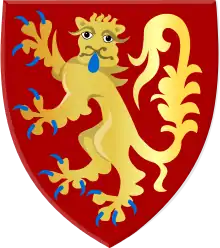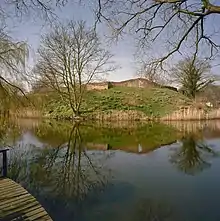Machteld van Voorne
Machteld van Voorne (c. 1300 - 12 March 1372) was Lady of Voorne, Monschau and Valkenburg, and burgrave of Zeeland. During the Hook and Cod wars she was an important ally of Count William V of Holland.
Machteld van Voorne | |
|---|---|
| Lady of Voorne | |
 Coat of arms of Voorne from the Beyeren Armorial | |
| Predecessor | Gerard van Voorne (?-1337) |
| Born | c. 1300 |
| Died | 12 March 1372 |
| Mother | Heilwich van Borselen |
Family
.jpg.webp)

In 1297 Gerard van Voorne married Heilwich van Borselen. From this marriage were born: Willem (?-1319), Albert (?-1331), Katharina van Vornenburg (?-1366), and Machteld van Voorne.[1] It is supposed that Machteld was born a few years after Gerard's marriage, i.e. about 1300.[2]
For a long time it seemed that Machteld would have a very traditional role as a nobleman's wife. She first had a brother Willem, and then a brother Albert, who were supposed to succeed to the Lordship of Voorne.
In 1323 Machteld married the widower Dirk Loef III lord of Kervenheim en Oedt. He is often known as Count of Hülchrath, but had sold this domain in 1322, and soon styled himself only as Lord of Kervenheim and Oedt (near Grefrath). It is supposed that Dirk and Machteld took up residence at Uda Castle in Oedt. In general Dirk Loef III was very unsuccessful in his finances, he died in 1332.[2]
Career
Potential heiress of Voorne
On 25 September 1331 Albert of Voorne died[1] during a tournament in London. It made Machteld the possible heiress of Voorne, because the Lords of Voorne held it from Holland: like the Counts held Holland from the empire.[3][1] In the hope of producing a new heir, Machteld's father Gerard then quickly married Elizabeth van Kleef (?-1382) in 1332.[4]
Machteld's brother's death made that on becoming a widow in 1332, Machteld was a desirable widow that might one day inherit Voorne. In 1336 she remarried to Dirk IV van Valkenburg. He had been destined for the clergy, but after his older brother died, he became a layman again in order to succeed his father. He was lord of Valkenburg, with its famous castle, and Monschau. Dirk fought a lot of wars.
Lady of Voorne
On 20 April 1337 Machteld's father Gerard died.[1] On 30 September 1337 Count William IV of Holland then granted all of Gerard's fiefs to Machteld.[5] In return Machteld and Dirk promised to help the count with 150 knights and squires at their own cost in times of war. There was an exception for wars against their liege lords the Duke of Brabant, or the Count of Guelders.[6] They also promised not to allow any marriage of Joan, daughter of Albert without consent of the count.[7]
Rule
The Lady of Voorne ruled the island Voorne with the town Brielle from the Burcht of Voorne in Oostvoorne. She also had possessions on the island Goeree also known as Westvoorne. Other lordships were on the islands Overflakkee and Schouwen-Duiveland. The lords of Voorne even held lands north of the Meuse, in Utrecht, the Betuwe, Flanders etc.[1]
The office of burgrave traditionally gathered a lot of income for the lords of Voorne. However, in 1328 the count of Holland had been as wise to buy off these rights. The burgraves kept the title and the prestige that the office brought.[1]
Machteld is remembered for the city rights she gave to Brielle in 1343. She was also involved in creating new polders. She successfully defended the economic interests of Brielle against those of Dordrecht, who wanted to establish a monopoly in the trade of certain goods. In 1349 she founded a chapter dedicated to Pancras of Rome at the grounds of the Burcht van Voorne.[2]
The Hook and Cod Wars
After Willem IV of Holland died at Staveren in September 1345, he was succeeded by his sister Maragaret of Hainaut. On 18 April 1346 one of her first acts was to rule that her son Otto V, Duke of Bavaria would succeed to the lordship of Voorne on Machteld's death.[7] This was not to the liking of Machteld, because the previous settlement left open the possibility that her niece Joan would succeed her. When the Hook and Cod wars erupted, Machteld would do anything to help William.[8]
The opportunity for vengeance arrived when Margaret's fleet approached the Meuse in July 1351. Machteld sent troops that helped to defeat Margaret in the Battle of Zwartewaal.[9] The battle was fought offshore of Machteld's village Zwartewaal.
Final years
Whatever the defeat of Margaret of Hainaut, it did not make that the decision to give Voorne to Otto of Bavaria was overturned. In June 1358 a treaty between Louis the Roman and count Albert of Holland, confirmed the gift to Otto.[10] However, when Machteld died in 1371 or early 1372, Albert kept her inheritance for himself as liege lord. He did give several pretenders a piece of her inheritance.[11]
Offspring
Machteld did not have any children.
References
- Aurelius, Cornelis; De Hamer, Aarnoud (2011), Die cronycke van Hollandt, Zeelandt ende Vrieslant, met die cronike der biscoppen van Uutrecht (Divisiekroniek), HES Uitgevers, Utrecht
- Van Engen, Hildo (2014), "Machteld van Voorne", Digitaal Vrouwenlexicon van Nederland, Instituut voor Nederlandse Geschiedenis, Den Haag
- Hoek, C. (1972), "De ontwikkeling gedurende de dertiende eeuw van het verdedigbare bakstenen huis in het Maasmondgebied" (PDF), Holland regionaal-historisch tijdschrift, Historische vereniging voor Zuid-Holland, no. 5, pp. 201–239
- De Jonge, J.C. (1817), Verhandeling over den Oorsprong der Hoeksche en Kabeljauwsche Twisten (PDF), H.W. Hazenberg, Leiden
- Kort, J.C. (1972), Inventaris van het archief van de Heren van Voorne, Burggraven van Zeeland, 1272-1371, Nationaal Archief, Den Haag
- Van Mieris, Frans (1754), Groot charterboek der graaven van Holland, van Zeeland, en heeren van Vriesland, vol. II, Pieter vander Eyk, Leyden
- Van Mieris, Frans (1755), Groot charterboek der graaven van Holland, van Zeeland, en heeren van Vriesland, vol. III, Pieter vander Eyk, Leyden
Notes
- Kort 1972.
- Van Engen 2014.
- Van Mieris 1754, p. 32.
- Van Mieris 1754, p. 529.
- Van Mieris 1754, p. 596.
- Van Mieris 1754, p. 597.
- Van Mieris 1754, p. 598.
- De Jonge 1817, p. 65.
- Aurelius & De Hamer 2011, p. 213v.
- Van Mieris 1755, p. 48.
- Van Mieris 1755, p. 265.